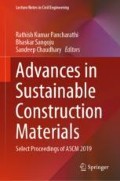Abstract
Concrete is being acknowledged as the second mostly used material worldwide after water but unfortunately, it is also the second largest generator of carbon dioxide from cement production after the automobile industry. It has become inevitable to find a better suitable alternative for cement to reduce carbon footprint. Geopolymer concrete is in fact, a step towards this direction in which concrete is being produced without the use of conventional cement. It also encourages the use of industrial wastes as binder due to its chemical action with alkaline solutions to produce in-organic molecule. The present application of geopolymer concrete is mostly restricted to precast construction. In precast construction, connective distress is witnessed in shear interface regions where shear stresses may lead to sliding failure along the well-defined plane in structures like corbel, bearing shoe, etc. This paper deals with interfacial shear strength study on fly ash and ground granulated blast slag (GGBS) based geopolymer concrete for different grades of concrete without and with shear reinforcement. An equation is developed for shear strength of geopolymer concrete.
Access this chapter
Tax calculation will be finalised at checkout
Purchases are for personal use only
References
ACI Committee 711 (1953) Minimum standard requirements for precast concrete floor units (ACI 711-53). ACI J Proc 50(9):1–15
ACI (American Concrete Institute) (2014) Building code requirements for reinforced concrete. ACI 318-14
Anderson AR (1960) Composite designs in precast and cast-in-place concrete. Prog Archit 41(9):172–179
Beverly P (ed) (2013) FIB model code for concrete structures 2010. Ernst & Sohn
Birkeland PW, Birkeland HW (1966) Connections in precast concrete construction. J Proc 63(3):345–368
BIS (Bureau of Indian Standards) (1999) IS 12089: Indian standard specifications for granulated slag for the manufacture of Portland slag cement
BIS (2003) IS 3812: Specification for fly ash for use as pozzolana and admixture
Davidovits J (1991) Geopolymers: inorganic polymeric new materials. J Therm Anal Calorim 37(8):1633–1656
García-Lodeiro I et al (2007) Durability of alkali-activated fly ash cementitious materials. J Mater Sci 42(9):3055–3065
IS: 383 (2016) Specification for coarse and fine aggregates from natural sources for concrete
Lee WKW, Van Deventer JSJ (2002) The effects of inorganic salt contamination on the strength and durability of geopolymers. Colloids Surf A 211(2–3):115–126
Mattock AH, Hawkins NM (1972) Shear transfer in reinforced concrete-recent research. PCI J 17(2)
Randl N (1997) Investigations on transfer of forces between old and new concrete at different joint roughness. Doctoral dissertation, Ph.D. thesis. Austria, University of Innsbruck
Rao GM, Rao TD, Seshu RD, Venkatesh A (2016) Mix proportioning of geopolymer concrete. Cem Wapno Beton 21(4):274–285
Shaikh AF (1978) Proposed revisions to shear-friction provisions. PCI J 23(2):12–21
Standard CSA (2014) Design of concrete structures, 6th edn., vol A23. Canadian Standards Association, Mississauga, Ontario, pp 3–14
Sumanth Kumar B, Seshu DR (2018) Binder index as criteria for assessing the strength of geopolymer concrete. J Struct Eng SERC, Chennai 46(1):12–16, April–May 2019
Author information
Authors and Affiliations
Corresponding author
Editor information
Editors and Affiliations
Rights and permissions
Copyright information
© 2020 Springer Nature Singapore Pte Ltd.
About this paper
Cite this paper
Sumanth Kumar, B., Sen, A., Rama Seshu, D. (2020). Shear Strength of Fly Ash and GGBS Based Geopolymer Concrete. In: Pancharathi, R., Sangoju, B., Chaudhary, S. (eds) Advances in Sustainable Construction Materials. Lecture Notes in Civil Engineering, vol 68. Springer, Singapore. https://doi.org/10.1007/978-981-15-3361-7_8
Download citation
DOI: https://doi.org/10.1007/978-981-15-3361-7_8
Published:
Publisher Name: Springer, Singapore
Print ISBN: 978-981-15-3360-0
Online ISBN: 978-981-15-3361-7
eBook Packages: EngineeringEngineering (R0)

